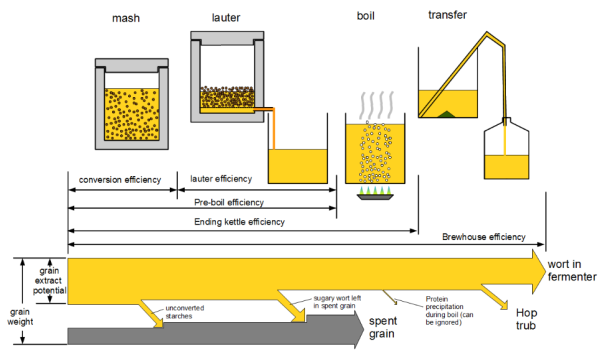sicktght311
Well-Known Member
- Joined
- Oct 16, 2018
- Messages
- 686
- Reaction score
- 304
So I consistently see people talking about getting 80%+ efficiencies with their 3vessel herms system, whether thats Spike, or SSBrewtech, or homemade, yet i cant seem to break 74-75%.
Equipment - I have 3x 10 gallon kettles in an e-herms configuration. I have a HLT with a 25foot SS herms coil, mash tun with a flat false bottom raised about 2.5" off the bottom of the kettle, and a boil kettle.
Process - I have my own grain mill and i mill to around .045 with a good crush. I attempted to mill finer, only to either end up with a stuck mash and a trickle in my recirculation, or in the end still see no change in efficiency. I usually run about 1.4-1.5quarts per lb in terms of mash thickness, although to get that i have to add about 2 extra gallons to account for the space under the false bottom. I mash in stirring vigorously to make sure the mash is nicely mixed, and no dough balls (which i never find at the end of the mash when i'm scooping out), and I recirculate on 1/2 to 3/4 speed through the entire 60 minute mash. I raise the mash temp to 168 for 10 minutes at the end of the mash (takes about 15ish minutes to get there), i reconfigure my hoses and i fly sparge. I keep about an inch of water over the top of the grain bed with a hose laying on top like the Kal system and it takes me about 45 minutes to collect my typically preboil volume of 6.75-7gallons. I used to calculate the exact amount of water needed for sparging and shut off my sparge pump when i hit that number and then let the tun drain, but now i also just run it continuously until i hit my preboil volume and i've noticed no changes in my efficiency.
My efficiency is dead on every time. 74-75% if i'm using Briess or similar 2-row as my base malt, 70% if i'm using Viking 2-row. I'm never more than 1-2 gravity points away from my target
Tell me where i'm going wrong and why i cant seem to get my efficiency up
Equipment - I have 3x 10 gallon kettles in an e-herms configuration. I have a HLT with a 25foot SS herms coil, mash tun with a flat false bottom raised about 2.5" off the bottom of the kettle, and a boil kettle.
Process - I have my own grain mill and i mill to around .045 with a good crush. I attempted to mill finer, only to either end up with a stuck mash and a trickle in my recirculation, or in the end still see no change in efficiency. I usually run about 1.4-1.5quarts per lb in terms of mash thickness, although to get that i have to add about 2 extra gallons to account for the space under the false bottom. I mash in stirring vigorously to make sure the mash is nicely mixed, and no dough balls (which i never find at the end of the mash when i'm scooping out), and I recirculate on 1/2 to 3/4 speed through the entire 60 minute mash. I raise the mash temp to 168 for 10 minutes at the end of the mash (takes about 15ish minutes to get there), i reconfigure my hoses and i fly sparge. I keep about an inch of water over the top of the grain bed with a hose laying on top like the Kal system and it takes me about 45 minutes to collect my typically preboil volume of 6.75-7gallons. I used to calculate the exact amount of water needed for sparging and shut off my sparge pump when i hit that number and then let the tun drain, but now i also just run it continuously until i hit my preboil volume and i've noticed no changes in my efficiency.
My efficiency is dead on every time. 74-75% if i'm using Briess or similar 2-row as my base malt, 70% if i'm using Viking 2-row. I'm never more than 1-2 gravity points away from my target
Tell me where i'm going wrong and why i cant seem to get my efficiency up





































![Craft A Brew - Safale S-04 Dry Yeast - Fermentis - English Ale Dry Yeast - For English and American Ales and Hard Apple Ciders - Ingredients for Home Brewing - Beer Making Supplies - [1 Pack]](https://m.media-amazon.com/images/I/41fVGNh6JfL._SL500_.jpg)
























